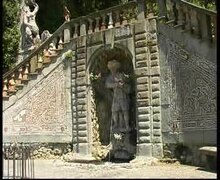Villa Garzoni
The Villa Garzoni is located in Collodi , Piazza della Vittoria 1; Pescia Municipality , Pistoia Province , Tuscany, Italy.
history
The name of the place Collodi is traced back to the old Roman road Via Clodia . Here the Romans laid a fortified place, the Forum Claudii . That became Clodi, which was then modified to Collodi.
The Garzoni family acquired the existing fortress in 1366 and expanded it into a family seat. The current villa was built at the beginning of the 17th century, probably before 1622, under Romano di Alessandro Garzoni. The architect is not known. A drawing from 1633 shows the villa still without a garden.
In 1959 the Garzoni line became extinct and the villa with garden went to the Sienese Count Giancarlo Gardi dell'Ardenghesca. He had a new bypass built, as all traffic had previously been routed through the facility. Today the villa and the garden are owned by the Gardi family and open to the public.
The Villa
The villa is a four-storey baroque building and the largest of the Lucca villas. The roof is adorned with an observation tower, a belvedere , with a wonderful view of the entire complex. Due to the hillside location, the entrance area at the rear of the villa leads directly to the piano nobile on the first floor. The frescoes in the salon and the baroque stucco cornices are by Angelo Michele Colonna .
The garden
The main axis of the garden does not run to the villa, but to the side of it. The first layout of the garden probably goes back to Romano di Alessandro Garzoni himself and was completed in 1652.
The garden begins in the flat French-style area with a broderieparterre ( parterre de broderie ) and two large circular basins with fountains. This part was added by Ottaviano Diodati in the 18th century. This is followed by a lawn parterre ( parterre à l'angloise ) with a lawn pattern and framing, wavy cut low hedges. Behind it the Garzoni coat of arms, made of colored stones.
The eye-catcher of the garden is the staircase lined with balustrades with arms running in opposite directions. In the landing there are grottoes and niches with statues of gods and simple farmers. At the top, the water tumbles down the slope over countless small pools like on a chain. The starting point on the hill is a statue of Fama , the deity of fame.
Carlo Lorenzini
The grandparents of the poet and author of the stories Pinocchio Carlo Lorenzini worked in the Villa Garzoni. That is why young Lorenzini was often here to visit. In memory of this happy time, he later adopted the pseudonym Collodi.
literature
- Germain Bazin : DuMont's History of Horticulture. License issue. Komet, Frechen 1999, ISBN 3-933366-01-1 .
- Torsten Olaf Enge, Carl Friedrich Schröer: Garden art in Europe. 1450-1800. From the villa garden of the Italian Renaissance to the English landscape garden. Taschen, Cologne 1990, ISBN 3-8228-0402-9 .
- Massimo Listri, Cesare M. Cunaccia: Italian Gardens. Fascinating garden art from 5 centuries. Bassermann, Niedernhausen 2001, ISBN 3-8094-0998-7 .
- Michel Saudan, Sylvia Saudan-Skira: Magic of the garden world. Taschen, Cologne 1997, ISBN 3-8228-7831-6 .
Web links
- Official website of Villa Garzoni (multilingual)
- Side of the city of Pescia to Collodi (Italian and English)
- www.toscana-lucca.de/sehenssame: Villa Garzoni (German)
Coordinates: 43 ° 53 ′ 59.9 " N , 10 ° 39 ′ 11.9" E


